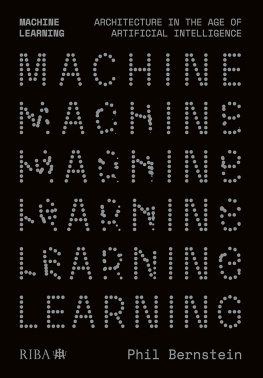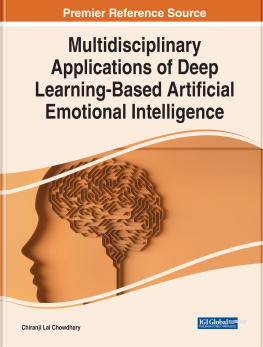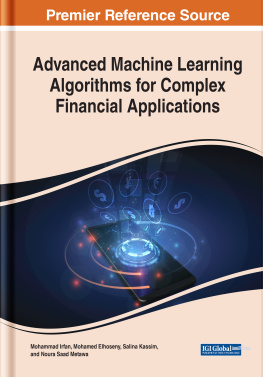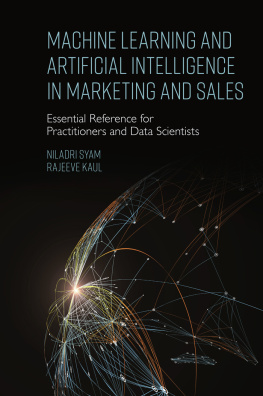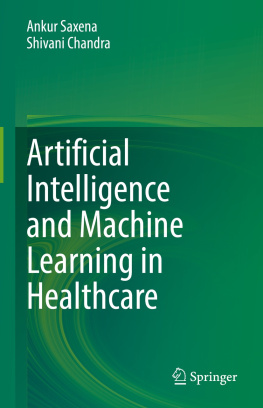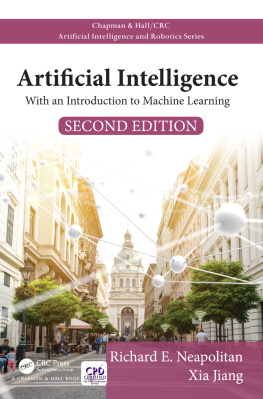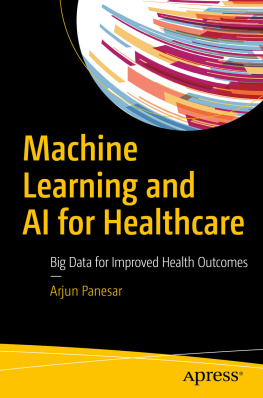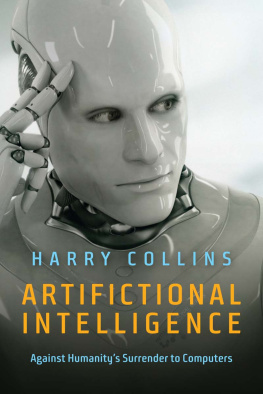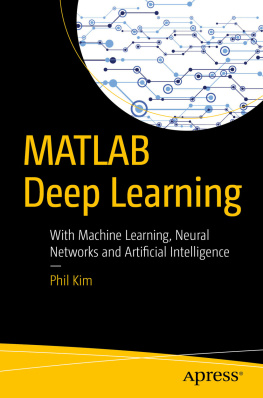
MACHINE LEARNING
ARCHITECTURE IN THE AGE OF ARTIFICIAL INTELLIGENCE

PhilBernstein

Phil Bernstein, 2022
Published by RIBA Publishing, 66 Portland Place, London, W1B 1AD
ISBN 9781 85946 401 3
The right of Phil Bernstein to be identified as the Author of this Work has been asserted in accordance with the Copyright, Designs and Patents Act 1988 sections 77 and 78.
All rights reserved. No part of this publication may be reproduced, stored in a retrieval system, or transmitted, in any form or by any means, electronic, mechanical, photocopying, recording or otherwise, without prior permission of the copyright owner.
British Library Cataloguing-in-Publication Data
A catalogue record for this book is available from the British Library.
Commissioning Editor: Clare Holloway
Assistant Editor: Scarlet Furness
Production: Richard Blackburn
Interiors designed and typeset by Studio Kalinka
Printed and bound by TJ Books, Cornwall
Cover design: The First 47
While every effort has been made to check the accuracy and quality of the information given in this publication, neither the Author nor the Publisher accept any responsibility for the subsequent use of this information, for any errors or omissions that it may contain, or for any misunderstandings arising from it.
www.ribapublishing.com
DOI: 10.4324/9781003297192
FRONT MATERIALS
ACKNOWLEDGEMENTS
When RIBA reached out to ask whether I might be interested in writing a book about the implications of artificial intelligence for the architecture profession, I was surprised to learn that another far-better known pundit (who shall remain unnamed) had declined a similar offer; apparently, the prospects, to him, were simply too dire. However, as the science-fiction writer William Gibson, of The Difference Engine fame, is purported to have said, 'the future is already here, it's just not evenly distributed'. Such is the case with the emergent technologies of Al, which lives on the smartphones (and thereby in the pockets) of the same architects who will be made redundant by our erstwhile robotic overlords.
What I did not realise as I started the project was that it would require me to return to my computational roots from decades ago, when I was an undergraduate student of an iconoclastic young professor at Yale, Roger Schank, who had some of the earliest foundational ideas for teaching computers to understand language. During my graduate studies, computing was emergent but largely unacknowledged, and my instructor at the time, Bob Frew, indulged my interest in using early computers (which were hardly up to any useful graphic task) for project management. Late in my final graduate year while on vacation in California, my uncle Edward Bernstein, always one to have the latest gadget, gave me a week with his brand-new Apple II Plus, on which was a new piece of software called VisiCalc, the first spreadsheet. Suddenly, numeric modelling no longer required hard coding and I surprised Bob with a finished project right after the holiday. Two years later in San Francisco, the architect Plerb McLaughlin sent me several times to Palo Alto, to research a new technology called 'expert systems', a provocative but otherwise completely unrealisable technology. Around the same time, I bought his firm's first personal computer - not for generating drawings, but to manage schedules and fee proposals. Computing to generate forms and images, I came to realise, is irresistible, but digital tools have just as much, if not more, agency in architectural process outside of design itself.
After a dozen years in mainstream practice with Csar Pelli and his managing partner, Fred Clarke, I joined Autodesk as a vice-president, and established there many of the relationships in the technology world that I maintain today. Jim Lynch, now a senior vice-president, is a close friend, sounding board and source of much help and insight from the company. Sam Omans, now an industry manager with Autodesk's Architecture/Engineering/Construction business (and likely one of the few folks working in tech with a PhD in architectural theory) has helped clarify ideas, locate information with the Autodesk labyrinth and chase down critical images that illuminate the text. Grace Liu, from the Autodesk Intellectual Property team, was invaluable in completing all the necessary image permissions there.
My thinking about the current state of Al technology owes a debt to Mark Greaves of the Pacific Northwest National Laboratory, who has also contributed the Foreword. During autumn 2020 I often met Mark, Steve McConnell of NBBJ and the writer Cliff Pearson via Zoom. Our regular Al salons, as we called them, replete with just a splash of scotch, did much to clarify for me what can be the daunting trajectory of the development of intelligent machines.
Here at Yale today I came to rely on our able architectural librarian in the Hass Arts Library, Tess Colwell, without whom I would have been unable to navigate the university's vast, but often opaque, resources. Dean Deborah Berke has been unfailingly supportive as I laboured to complete the manuscript while we steered the School of Architecture through the global pandemic. And my editors at RIBA Publishing - Clare Holloway, Scarlet Furness, Liz Webster, Richard Blackburn and Ramona Lamport - are exemplars of professionalism and patience, particularly with my peripatetic schedule. Clare was not fazed a bit when I asked for my long-time friend and collaborator, the editor Andreas Muller, to pitch in as an additional set of eyes on the project. Andreas, who edited my last manuscript, offered regular, clear and very useful advice to improve both the flow and logic of the argument.
A final note of thanks to my partner Nancy Alexander, who always creates the space in which to do important work and the reminders for why it is so important to stick to it. Without her unending support, none of these projects would ever be possible.
FOREWORD
When I first started working with Phil, I held the one-dimensional impression of architecture that he mentions early in the book: architecture as a discipline that translates desire and capital into occupiable space. Although truthful and concise, this formulation makes it disturbingly easy for computer scientists like me to view architects as people who mechanically execute a semi-formal translation function. It took several Zoom-mediated and whiskey-lubricated discussions of architecture and Al for Phil and his patient colleagues to gently disabuse me of this blinkered and reductionist view.
The change in my own conception of architecture is not unlike the recent and dramatic evolution of Al, which is why this book is so timely for both of our professions. In the last decade, Al has rapidly advanced from meticulously authored rule systems to the staggeringly complex world of deep learning networks and self-supervised methods. Instead of relying on collections of intricate rules manually programmed for specific tasks, modern machine learning systems now base their outputs on impenetrably complex patterns that result from automatically analysing massive data sets. Al-generated design, which was once mostly an academic exercise in combining rules in different ways, can now produce creations that are far more subtle and compelling.
Next page
